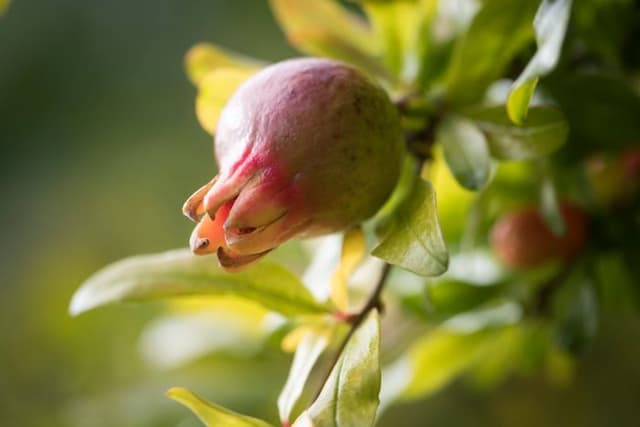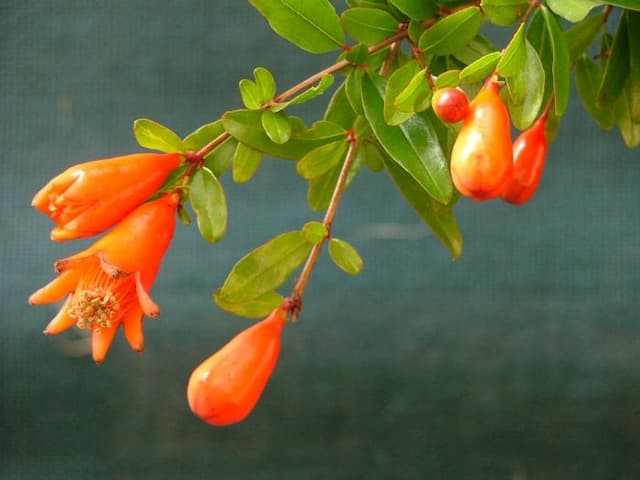Cigar Plant Cuphea ignea

ABOUT
Cuphea ignea, commonly known as the cigar plant, is a striking evergreen shrub known for its unique floral display. The most distinctive features of the cigar plant are its tubular, bright orange to reddish flowers which resemble little cigars or firecrackers, hence its common name. The tip of the flower is usually white or lighter in color and is sometimes fringed with what looks like ash, accentuating the resemblance to a lit cigar. The flowers of the cigar plant protrude from dark green, lance-shaped leaves that are glossy and add to the lush appearance of the foliage. The leaves are small to medium in size and are tightly packed along the stems, creating a dense canopy of greenery that serves as a perfect backdrop for the vibrant flowers. Branches of the cigar plant tend to be slender and may have a slightly arching habit, giving the plant a casual, free-flowing look. This casual elegance is further accentuated during the blooming period when it becomes covered in the striking, fiery-hued blooms. The overall appearance of the cigar plant is one of vivid color and festive charm, with its showy flowers attracting a variety of pollinators, including hummingbirds and butterflies, which adds movement and interest to the garden. The continuous bloom cycle of the cigar plant ensures a long-lasting display of color, making it a popular choice for gardeners looking to add a touch of the tropics to their landscape.
About this plant
 Names
NamesFamily
Lythraceae.
Synonyms
Cigar Plant, Cigar Flower, Firecracker Plant, Mexican Cigar Plant.
Common names
Cuphea platycentra, Parsonsia ignea
 Toxicity
ToxicityTo humans
Cuphea ignea, commonly known as the cigar plant, is not widely recognized as a poisonous plant to humans. There is limited information about its toxicity, and it does not appear on most toxic plant databases. Thus, the cigar plant is generally considered non-toxic to humans, and there are no well-documented symptoms of poisoning from the ingestion of its parts. However, as with any plant, individual allergies or sensitivities can occur, and it is always prudent to avoid ingesting parts of ornamental plants.
To pets
Cigar plant, known technically as Cuphea ignea, is not commonly listed as toxic to pets, including cats and dogs. There is a lack of substantial evidence to suggest that it has any toxic effects on animals commonly kept as pets. However, as with any non-food plant, ingestion may sometimes result in mild gastrointestinal upset due to irritation, or if the pet has a particular sensitivity. As such, it is generally advised to prevent pets from ingesting plants not intended for consumption.
 Characteristics
CharacteristicsLife cycle
Perennials
Foliage type
Evergreen
Color of leaves
Green
Flower color
Red
Height
1-2 feet (0.3-0.6 meters)
Spread
1-2 feet (0.3-0.6 meters)
Plant type
Shrub
Hardiness zones
10
Native area
Mexico
Benefits
 General Benefits
General Benefits- Attracts Pollinators: Cuphea ignea, commonly known as cigar plant, is known to draw in hummingbirds and butterflies, which are beneficial for pollination.
- Drought Tolerant: Once established, the cigar plant is drought-tolerant, making it suitable for xeriscaping and low-water gardens.
- Decorative Flowers: The tubular, bright reddish-orange flowers add a splash of color to the garden and can enhance the aesthetic of any landscape.
- Easy to Grow: This plant is relatively low-maintenance and adapts well to a variety of soil types, which is ideal for novice gardeners.
- Long Blooming Period: The cigar plant produces flowers for a long duration, often from early summer until the first frost, providing extended garden interest.
 Medical Properties
Medical PropertiesThis plant is not used for medical purposes.
 Air-purifying Qualities
Air-purifying QualitiesThis plant is not specifically known for air purifying qualities.
 Other Uses
Other Uses- Hummingbird Attractant: Due to its bright red, tube-shaped flowers, Cuphea ignea is frequently used in gardens to attract hummingbirds.
- Butterfly Garden Plant: The nectar of the flowers is also attractive to butterflies, making it a suitable candidate for butterfly gardens.
- Teaching Tool: Sometimes used in educational settings to demonstrate plant-animal interactions, especially pollination mechanisms.
- Conservatory Plantings: Cuphea ignea is used in conservatories and greenhouses for its colorful appearance and ease of growth under controlled conditions.
- Bonsai: Some gardeners experiment with Cuphea ignea in bonsai form, due to its manageable size and interesting flowers.
- Photography Subjects: The vibrant flowers of Cuphea ignea make it a popular choice for photographers specializing in botanical and macro photography.
- Landscape Borders: This plant can be used to create vivid borders along walkways or garden edges with its dense and colorful foliage.
- Potpourri Ingredient: Dried flowers and leaves of Cuphea ignea can sometimes be included in potpourri mixes for their shape and color.
- Artistic Inspiration: The unique appearance of Cuphea ignea often inspires artists and crafters in their botanical illustrations and nature-inspired designs.
- Cultural Celebrations: In some regions, the plant is incorporated into cultural events and festivals, often as part of floral decorations or thematic displays.
Interesting Facts
 Feng Shui
Feng ShuiThe plant Cuphea ignea, commonly known as the cigar plant, is not used in Feng Shui practice.
 Zodiac Sign Compitability
Zodiac Sign CompitabilityThe cigar plant is not used in astrology practice.
 Plant Symbolism
Plant Symbolism- Attraction: Cuphea ignea, commonly known as Cigar Plant, has bright, tubular flowers that attract hummingbirds and butterflies, thus symbolizing the power of allure and magnetism.
- Vibrancy: The Cigar Plant's vivid red-orange flowers represent liveliness and high-spirited energy, showcasing a sense of vibrancy in the garden.
- Passion: The fiery color of this plant's blooms are often associated with intense passion and strong emotions.
- Warmth: The warm-toned flowers of the Cigar Plant symbolize hospitality and a welcoming environment.
- Endurance: Cuphea ignea is known for its resilience and long blooming season, thus symbolizing perseverance and stamina.
 Water
WaterThe Cigar Plant requires consistent moisture and should be watered once the top inch of soil feels dry to the touch. In general, this could be approximately once a week, but it varies depending on environmental conditions such as temperature and humidity. Use lukewarm water and pour evenly around the base of the plant until the water starts draining from the bottom of the pot, indicating that the soil is thoroughly moistened. About 16 to 24 ounces of water per week is often sufficient for a medium-sized pot, but always adjust based on the plant's response and the season. During the hotter, dryer months, more frequent watering may be necessary, while in the cooler months less water is often required.
 Light
LightThe Cigar Plant thrives in bright, indirect light and can tolerate direct sunlight, especially in the cooler parts of the day. The best spot for Cuphea ignea is near a window that receives ample morning sun or filtered light throughout the day. Avoid placing it in full shade or dark corners where lack of light can impede flowering.
 Temperature
TemperatureCuphea ignea, or Cigar Plant, prefers warm environments and should be kept in temperatures between 60 to 85 degrees Fahrenheit. While this plant can survive a minimum temperature of around 50 degrees Fahrenheit, temperatures below this can cause damage. The ideal conditions for the Cigar Plant are on the warmer side of its range, avoiding any sudden drops in temperature or cold drafts.
 Pruning
PruningPrune the Cigar Plant to maintain its shape and encourage bushier growth. Trimming can be done lightly throughout the growing season as needed. The best time for a more thorough pruning is in the early spring, just before new growth begins. Remove any dead or damaged stems, and cut back leggy growth to promote more vigorous stems and increased flowering.
 Cleaning
CleaningAs needed
 Soil
SoilThe cigar plant (Cuphea ignea) thrives in well-draining soil enriched with organic matter such as peat, compost, or well-rotted manure. A suitable mix can consist of one part potting soil, one part perlite or coarse sand, and one part organic matter. The ideal pH range for cigar plants is slightly acidic to neutral, around 6.0 to 7.0.
 Repotting
RepottingCigar plants (Cuphea ignea) should be repotted every one to two years to refresh the soil and accommodate root growth. Choose a pot that is only slightly larger than the current one to prevent overwatering. Spring or early summer is the best time to repot.
 Humidity & Misting
Humidity & MistingCigar plants (Cuphea ignea) prefer high humidity environments, with ideal levels ranging from 50% to 70%. If the air is too dry, especially indoors, use a humidity tray or a room humidifier to increase moisture around the plant.
 Suitable locations
Suitable locationsIndoor
Place your cigar plant in bright, indirect light indoors.
Outdoor
Plant cigar plant in a sunny to partly-shaded spot outdoors.
Hardiness zone
10-12 USDA
 Life cycle
Life cycleCuphea ignea, commonly known as the cigar plant, begins its life as a seed that germinates in warm, moist soil, typically during spring or early summer. Upon sprouting, the seedling emerges, developing its initial set of true leaves and establishing a small root system. As it enters the vegetative growth stage, the cigar plant focuses on leaf and stem development, rapidly increasing in size and producing the characteristic lance-shaped leaves. It then transitions to the flowering stage, where tubular, bright red or orange flowers that resemble lit cigars appear, which is particularly attractive to hummingbirds and pollinating insects. After pollination, the flowers produce small capsules containing seeds, completing the reproductive stage. As a perennial in warmer climates or an annual in cooler regions, Cuphea ignea may enter a dormant phase during colder months or complete its life cycle with seed production before dying.
 Propogation
PropogationPropogation time
Spring-Early Summer
Cuphea ignea, commonly known as the cigar plant due to its cigar-shaped flowers, is most commonly propagated using stem cuttings. This is typically done in spring or early summer when the plant is actively growing. To propagate from stem cuttings, a gardener should select a healthy, non-flowering stem and cut a segment roughly 4 to 6 inches (10 to 15 centimeters) long, making sure there are multiple leaf nodes present. The lower leaves are removed, and the cutting is inserted into a well-draining soil mix and kept moist. A rooting hormone can be applied to the cut end to encourage root development, although this is not always necessary. The cutting should be placed in indirect sunlight and should root within a few weeks, at which point it can be transplanted to a more permanent location.




